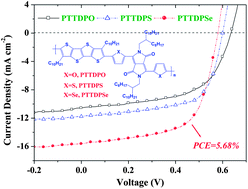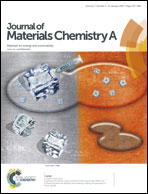Synthesis and photovoltaic performance of low band gap copolymers based on diketopyrrolopyrrole and tetrathienoacene with different conjugated bridges
Abstract
Using tetrathienoacene (TT) and diketopyrrolopyrrole (DPP) units as donor and acceptor blocks, three new low band gap (LBG) conjugated copolymers (PTTDPO, PTTDPS and PTTDPSe) with different heterocycle bridges (furan, thiophene and selenophene) were designed and synthesized by Stille coupling polymerization reactions. Their structures were verified by 1HNMR spectroscopy and elemental analysis. All these copolymers exhibit broad absorption bands with small band gaps. UV-vis absorption spectra and cyclic voltammetry (CV) measurements indicated that the selenophene inclusion resulted in a reduction in the band gap, which could be attributed to a reduction of oxidation potentials and an increase of the electron affinities of the related copolymer. The density functional theory (DFT) calculations showed that PTTDPSe with selenophene bridges favoured a much more planar conformation than PTTDPO and PTTDPS, which afforded a higher hole mobility of 7.9 × 10−4 cm2 V−1 s−1. Photovoltaic properties of the copolymers blended with [6,6]-phenyl-C71-butyric acid methyl ester (PC71BM) as an electron acceptor were investigated. The polymer solar cell (PSC) based on the structure of ITO/PEDOT:PSS/PTTDPSe:PC71BM (1 : 1.5, w/w)/Ca/Al exhibited a high power conversion efficiency (PCE) of 5.68% with an improved short circuit current density (Jsc) of 15.62 mA cm−2. The primary results show that changing heterocycle bridges with different electron-donating ability can easily and finely tune the optical absorptions, band gaps and energy levels of DPP-containing copolymers. The results also demonstrate that the TT unit is a new and promising electron-donating donor block for constructing highly efficient LBG photovoltaic materials.


 Please wait while we load your content...
Please wait while we load your content...